Tuesday, 16 June 2009, Mustard and charity
Written 20 June 2009
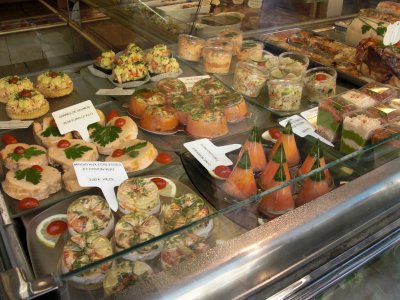
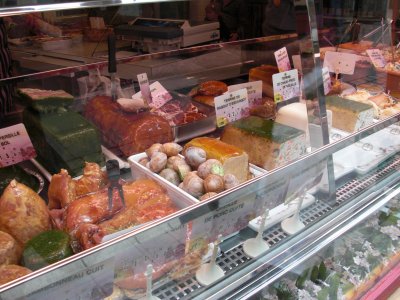 Tuesday, the sun came out, so we set off toward the Office de Tourisme to see what Beaune had to offer. Along the way, in addition to the lively Place Carnot (with antique carousel in the center, of course), we passed many gorgeous shop windows—Beaune is particularly rich in "traiteurs" (prepared-food shops). The traiteur window on the left features mostly cold seafood (the meats were in the next case to the right)—smoked salmon in aspic, glazed poached salmon steaks, shrimp with lemon, etc. The one on the right shows mainly "charcuterie" (cured pork products) in the foreground, then various terrines further to the right. T he entirely green loaf at the left is "jambon persillé" (parsleyed ham), a great local specialty. A container (usually loaf or hemisphere shaped) is lined with ham-flavored aspic thickly studded with minced parsley. Then the rest is filled with a mixture of the same aspic and chunks of cooked ham, which gels when chilled. When sliced, it presents a lovely pink and green mosaic. The cones are small rolled hams. Next to them are cooked pigs' feet in aspic, then snails (cooked, replaced in the shell, and filled with garlic-parsley butter, ready for heating in the oven). The central green-topped loaf is a chilled terrine of ragout of snails and vegetables. It's intended to be sliced and eaten cold, but I'm sure they would also sell you a tub of ready-to-reheat snail ragout to be eaten hot.
Tuesday, the sun came out, so we set off toward the Office de Tourisme to see what Beaune had to offer. Along the way, in addition to the lively Place Carnot (with antique carousel in the center, of course), we passed many gorgeous shop windows—Beaune is particularly rich in "traiteurs" (prepared-food shops). The traiteur window on the left features mostly cold seafood (the meats were in the next case to the right)—smoked salmon in aspic, glazed poached salmon steaks, shrimp with lemon, etc. The one on the right shows mainly "charcuterie" (cured pork products) in the foreground, then various terrines further to the right. T he entirely green loaf at the left is "jambon persillé" (parsleyed ham), a great local specialty. A container (usually loaf or hemisphere shaped) is lined with ham-flavored aspic thickly studded with minced parsley. Then the rest is filled with a mixture of the same aspic and chunks of cooked ham, which gels when chilled. When sliced, it presents a lovely pink and green mosaic. The cones are small rolled hams. Next to them are cooked pigs' feet in aspic, then snails (cooked, replaced in the shell, and filled with garlic-parsley butter, ready for heating in the oven). The central green-topped loaf is a chilled terrine of ragout of snails and vegetables. It's intended to be sliced and eaten cold, but I'm sure they would also sell you a tub of ready-to-reheat snail ragout to be eaten hot.
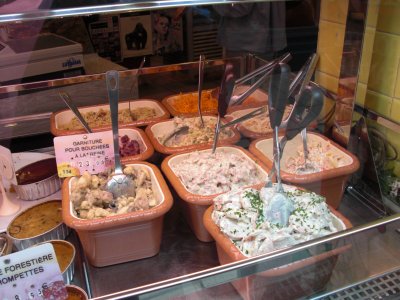
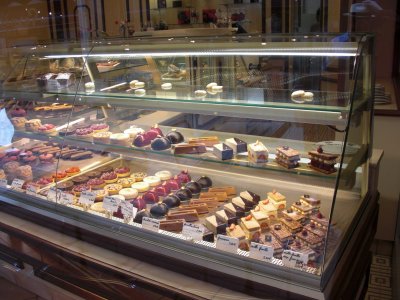 At the left here is more of one of the windows above. The labeled tub is filling for "bouchées à la reine" (i.e. puff pastry shells filled with creamed mushrooms and chicken). Others are various potato and vegetable salads.
At the left here is more of one of the windows above. The labeled tub is filling for "bouchées à la reine" (i.e. puff pastry shells filled with creamed mushrooms and chicken). Others are various potato and vegetable salads.
At the right is part of a pastry-shop window—sore temptation, even right after breakfast.
Despite pausing to admire so many windows, we eventually reached the Place du Marché, where our guidebook indicated the Office de Tourism to be. The building was open, and piles of various brochures were made available, but it was deserted, and a sign on the door explained that the office had moved! So we made the detour and finally found the place, conveniently next door to the Musée des Beaux Arts. The hotel had given us a little booklet with a map of Beaune and a long list of places to visit, and most indicated that they were included in something called a "Passe Beaune," so we asked where we could get one of these passes. What the deal turns out to be is that, if you buy all your tickets for attractions in the booklet, all at the same time, there in the tourist office, you get discounts on most of them. If that had been explained in advance, we could have arrived prepared, but as it turned out, we stood there at the desk (while a line formed behind us), flipping throught the booklet and picking out our itinerary for the next few days, making reservations for the two items that required it (the Fallot mustard factory and the Safari vinyard tour), and buying tickets for a bunch of others. At the end, she gave us a little folder, just like an airline ticket wallet, full of tickets that looked just like those flimsy paper boarding passes, each admitting two adults to one of the attractions—two at reserved times and the rest anytime in the next two weeks.
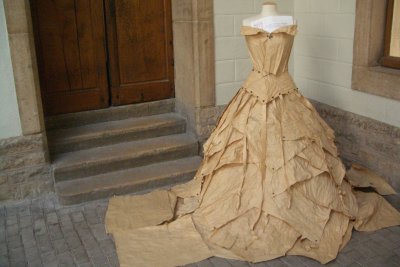 While we were there, we cast an eye over a display of art by school children on the theme "Vegetal." Some cute stuff, but the best was this collaborative piece by four students, held over from a previous theme, "packaging."
While we were there, we cast an eye over a display of art by school children on the theme "Vegetal." Some cute stuff, but the best was this collaborative piece by four students, held over from a previous theme, "packaging."
Written 21 June 2009
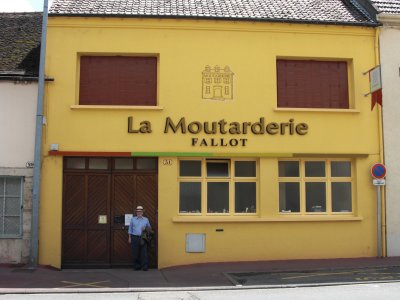 Then it was off to our first appointment, the 11:30 a.m. tour of La Moutarderie Fallot, located next door to last night's restaurant. On the internet, I had read a rather disparaging account of the tour by someone who was scandalized to learn that "Dijon mustard" was only a recipe, and in the public domain at that, rather than an "appellation controlée," but we thought it was great. Unfortunately, we didn't get actually to see the mustard being made, although later visitors will; the company is in the process of installing a system of viewing windows that will let tourists overlook the production floor without risk of contaminating the product (or being overcome by mustard fumes). Tours are limited to 20 people, and ours was about full but with people as sincerely interested as we were, so it went very well.
Then it was off to our first appointment, the 11:30 a.m. tour of La Moutarderie Fallot, located next door to last night's restaurant. On the internet, I had read a rather disparaging account of the tour by someone who was scandalized to learn that "Dijon mustard" was only a recipe, and in the public domain at that, rather than an "appellation controlée," but we thought it was great. Unfortunately, we didn't get actually to see the mustard being made, although later visitors will; the company is in the process of installing a system of viewing windows that will let tourists overlook the production floor without risk of contaminating the product (or being overcome by mustard fumes). Tours are limited to 20 people, and ours was about full but with people as sincerely interested as we were, so it went very well.
The company was founded in 1840, when Beaune alone harbored 35 mustard makers, and has been named "Fallot" since 1928. Now only four companies make mustard in all of Burdundy, and Fallot is the only one in Beaune and the only one in France that still stone-grinds its mustard. Just 20 people work there. The guide explained that stone crushes and pulverizes the mustard seed more slowly and thoroughly (as opposed to chopping it, as metal mills do) and therefore liberates more of the natural oils and aromatics, for better flavor. (The stones must be periodically "repointed" (i.e., their grooves recut) as they wear down.) As a result Fallot mustard is considered the highest in overall quality, and many famous chefs all over France (Bocuse, etc.) commission their own "house label" mustards from Fallot.
The tour started with a video about the history of mustard (starting in Asia, esteemed by the Romans, etc.), but it was projected on a blotchy, rough-cut stone wall and the voice-over was almost drowned out by the background music, so it was largely incomprehensible. Next, the guide explained the mustard-making process—cleaning of the mustard seed, soaking in wine or vinegar, grinding, seasoning, blending, etc. Prepared mustard consists basically of ground mustard seed, an acid liquid (at one point verjus, but historically and presently, either vinegar or wine), and salt. Other flavorings can be added as desired; the husks can be sifted out or not. Then we got a short audioguided tour of historical mustard-making equipment, a chance to taste raw mustard seed (not bad!; mustard makers use only the tiny brown kind of mustard seed, not the larger, ivory-colored ones used, e.g., in pickling, because the latter aren't piquant), and another film—in the paper-doll animation style popularized by Monty Python—that was much more effective.
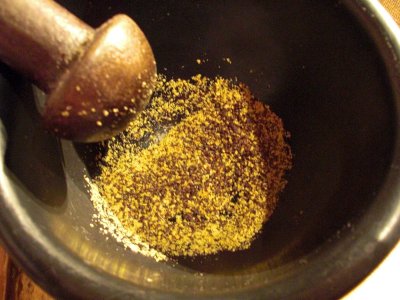
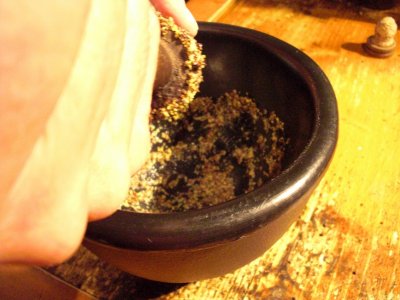 Next, we got to make our own mustard! Several good-sided mortars and pestles were supplied and we were instructed (well, we just looked on while others did the grinding, as there weren't enough mortars for everyone) to start with a small handful of seed and grind it thoroughly, then to add a little of the wine-vinegar mix supplied, and a little salt before tasting the result. Everyone wound up adding too much salt, and the result was a little bitter, but the guide assured us that was normal—over the next few hours, with continued mixing, the bitterness would disappear.
Next, we got to make our own mustard! Several good-sided mortars and pestles were supplied and we were instructed (well, we just looked on while others did the grinding, as there weren't enough mortars for everyone) to start with a small handful of seed and grind it thoroughly, then to add a little of the wine-vinegar mix supplied, and a little salt before tasting the result. Everyone wound up adding too much salt, and the result was a little bitter, but the guide assured us that was normal—over the next few hours, with continued mixing, the bitterness would disappear.
As had been explained to us before, 95% of all mustard seed used by the makers in France comes from Canada, but Fallot has recently started a movement to reverse that. The company has contracted with some local farmers to raise mustard seed near Beaune, and from it they are making a version of Dijon mustard that will be "appelation controllée"—they're calling it "Moutarde de Bourgogne," and it will be made only from mustard seed grown in Burgundy. Watch for it in stores near you.
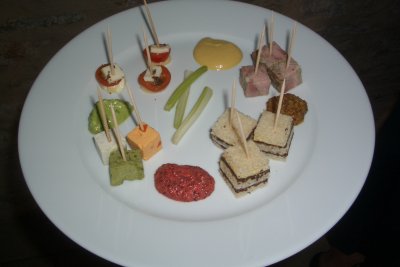 Finally, we were ushered into a tasting room, where the cloches were whisked off many small plates like this for our mustard tasting. Clockwise from the dollop of yellow "Moutarde de Bourgogne" at the top: cubes of pressed ham, coarse-grained pain d'épices mustard, minced-olive sandwiches, coarse-grained black-currant mustard, cubes of assorted vegetable terrines, smooth basil mustard, and tomato-mozzarella bites. Celery in the center.
Finally, we were ushered into a tasting room, where the cloches were whisked off many small plates like this for our mustard tasting. Clockwise from the dollop of yellow "Moutarde de Bourgogne" at the top: cubes of pressed ham, coarse-grained pain d'épices mustard, minced-olive sandwiches, coarse-grained black-currant mustard, cubes of assorted vegetable terrines, smooth basil mustard, and tomato-mozzarella bites. Celery in the center.
During the tasting, a video ran of Paul Bocuse describing and preparing a recipe specifically calling for his house brand of Fallot mustard. Fish with capers, mustard, and hot melted better (I took notes!). At the end of the tour, each of us was presented with a tiny jar of Dijon-style mustard and one of pain d'épices mustard.
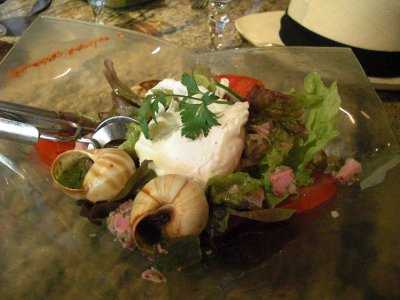 By this time, we were ravenous, so we went in search of lunch and found a great salad at a nearby café—jambon persillé, poached egg, and hot parsley-buttered snails. Fortified with that and a café liègeois for me, we set off to tour the Hospices de Beaune, also called the Hôtel Dieu.
By this time, we were ravenous, so we went in search of lunch and found a great salad at a nearby café—jambon persillé, poached egg, and hot parsley-buttered snails. Fortified with that and a café liègeois for me, we set off to tour the Hospices de Beaune, also called the Hôtel Dieu.
In the mid-15th century, Nicholas Rolin, chancellor to the Duc de Bourgogne, was getting old (60-ish) and wished to increase his chances of a good spot in heaven. He had visited Bruges and was very impressed by a charity hospital he had seen there, so he founded and endowed a bigger and better one in Beaune, a place where the sick and injured poor would be cared for free of charge. In particular, he copied a Flemish style by commissioning a colorful, geometrically patterned glazed-tile roof, the first one ever seen in France. It made a sensation, and as you can see from many of my photos, the idea was widely copied throughout the region. He approached a nursing order of nuns, who came to staff it. In the model, you can see its overall layout. The facade that faces the street, where you enter to start the tour, is the long, gray stone, "outside" wall of the slate-roofed building at the left. That slate roof is being replaced for the first time since the 19th century, so part of the outside facade was covered with scaffolding.
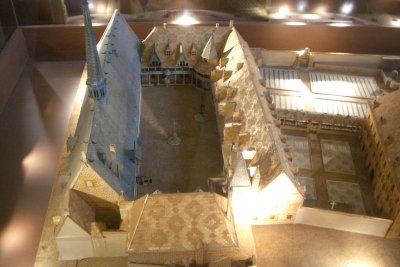
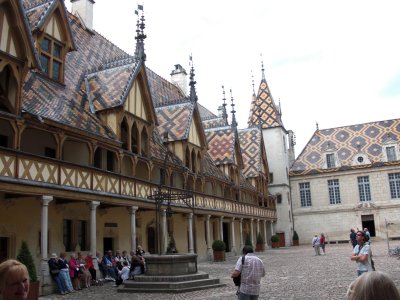 Only when you pass through that building and enter the courtyard do you see the spectacular roof and ornate woodwork. The well in the courtyard supplied all the water for the complex, and fortunately, it was very deep, drawing its water from far below the level of the bottom of the local river, which passes under the building and into which, through slots in the floor (now glassed over), was pushed all the garbage, sewage, and medical waste from the hospital.
Only when you pass through that building and enter the courtyard do you see the spectacular roof and ornate woodwork. The well in the courtyard supplied all the water for the complex, and fortunately, it was very deep, drawing its water from far below the level of the bottom of the local river, which passes under the building and into which, through slots in the floor (now glassed over), was pushed all the garbage, sewage, and medical waste from the hospital.
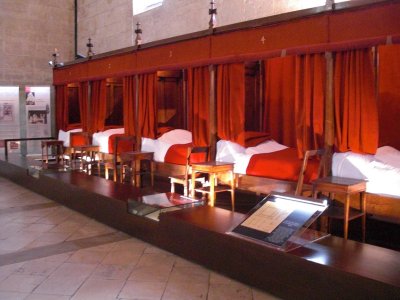 Inside one wing was the ward, fitted with 28 handsome and substantial curtained and canopied beds, each with its little side table and chair. the ceiling is extremely high (far overhead, "engoulants" hold the crossbeams in their wooden mouths), and the room is lit by windows above the beds. The ward held more than 28 patients, though, as each bed was occupied by two or three patients, sometimes four, at a time. The beds are rather short, as it was customary for the patients to sit up, at opposite ends of the bed, rather than to lie flat. The guide reminded us that these were the very poor, all badly injured or sick as dogs, many in pain and vocal about it, many dying. The nuns must have had their hands full. The nuns' sleeping quarters were on an upper floor of a wing, at right angles, and windows in the upper wall allowed them to keep watch over the ward at night. Two other, smaller rooms were also fitted as wards. The most striking feature of the wards, though, is that their architecture is that of a basilica, and for good reason—each is actually a church. That's why the place is also called the Hôtel Dieu—God's townhouse. At the end of each one is a choir and alter, just as in a regular Catholic church, and mass was said there, every three hours, round the clock, for the benefit of the patients (and for the soul of Nicholas Rolin).
Inside one wing was the ward, fitted with 28 handsome and substantial curtained and canopied beds, each with its little side table and chair. the ceiling is extremely high (far overhead, "engoulants" hold the crossbeams in their wooden mouths), and the room is lit by windows above the beds. The ward held more than 28 patients, though, as each bed was occupied by two or three patients, sometimes four, at a time. The beds are rather short, as it was customary for the patients to sit up, at opposite ends of the bed, rather than to lie flat. The guide reminded us that these were the very poor, all badly injured or sick as dogs, many in pain and vocal about it, many dying. The nuns must have had their hands full. The nuns' sleeping quarters were on an upper floor of a wing, at right angles, and windows in the upper wall allowed them to keep watch over the ward at night. Two other, smaller rooms were also fitted as wards. The most striking feature of the wards, though, is that their architecture is that of a basilica, and for good reason—each is actually a church. That's why the place is also called the Hôtel Dieu—God's townhouse. At the end of each one is a choir and alter, just as in a regular Catholic church, and mass was said there, every three hours, round the clock, for the benefit of the patients (and for the soul of Nicholas Rolin).
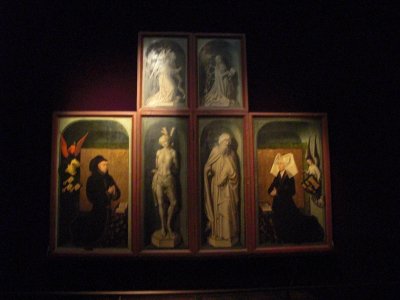
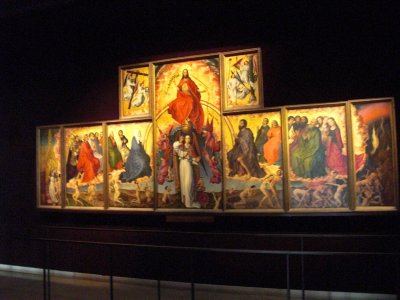 The altarpiece from the large ward, a world art treasure painted in strictly Flemish style, is displayed separately in a special dimly-lit, climate-controlled room. Closed, it shows Nicholas and his second wife, Guigone des Salins, kneeling in prayer and a couple of saints, all in muted colors. Open, it displays a brilliantly colored scene of the last judgement. (My wonderful little digital camera, this year's Christmas present, did an amazing job of capturing it without flash, even in the dim light.) A railing keeps you about five feet from it, but a giant lens, perhaps 18 inches across, is mounted on a frame that periodically slides back and forth and up and down across in front of the painting, pausing to magnify the best details. It is truly magnificent, although it serves to remind me that Flemish painting protrays no nudes, only naked people.
The altarpiece from the large ward, a world art treasure painted in strictly Flemish style, is displayed separately in a special dimly-lit, climate-controlled room. Closed, it shows Nicholas and his second wife, Guigone des Salins, kneeling in prayer and a couple of saints, all in muted colors. Open, it displays a brilliantly colored scene of the last judgement. (My wonderful little digital camera, this year's Christmas present, did an amazing job of capturing it without flash, even in the dim light.) A railing keeps you about five feet from it, but a giant lens, perhaps 18 inches across, is mounted on a frame that periodically slides back and forth and up and down across in front of the painting, pausing to magnify the best details. It is truly magnificent, although it serves to remind me that Flemish painting protrays no nudes, only naked people.
Rolin actually lived another twenty years after founding the Hospice, and Guigone also became heavily involved in managing the place, then continued to do so after his death, and to give generously to it, even after the steering committee (or whatever they called themselves at the time) brought suit to have her stripped of all authority (they lost). Other parts of the complex house an extensive pharmacy, a large kitchen, the nuns' quarters, etc. Perhaps most astonishing of all, the place is still a working nursing home! Part of its endowment is some exceedingly valuable land, right in the best parts of the Côtes de Beaune wine-producing region, so the Hospice owns and runs its own winery. The wine is sold at auction on the third Sunday of November every year, at the Beaune wine market, for many millions of dollars—it's the largest charity auction in the world. For the last few years, it's been run by Christie's, so you can log onto the web and participate in the auction if you want. With the proceeds and those from other parts of the endowment, the Hospice continues to run retirement homes and nursing homes in Beaune. The buildings outside the main quad are in such use, as are many other old houses and buildings in the city. The city was once home to about 30 convents, so many suitable institutional-sized buildings were available (the city hall is in one). French retirees who find themselves inadequately provided for can apply for admission.
The last thing the guide told us as we left was that, in the gift shop, they were selling the old slates from the roof—the ones from the 19th-century restoration! Now there's a souvenir! So I went to the shop and asked, with some trepidation, how much they cost and how much they weighed, and I was astonished to find that they cost just 3 euros each and were about the size and weight of a magazine. So now I too can serve my butter/cheese/sushi/whatever on a slab of rock, just like the big-shot French chefs, and I'll bet theirs didn't spend 100+ years on top of the Hospice de Beaune. Watch for it at my next party!
For dinner, we walked a few blocks out of town to l'Écusson ("the Escutcheon"), a nice little place with a friendly waitstaff.
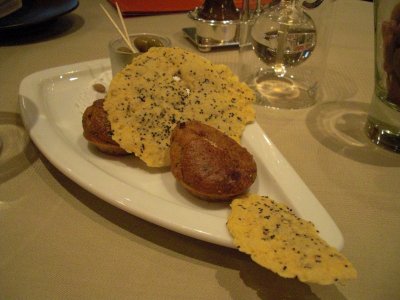
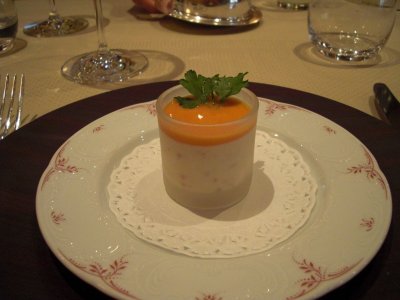 The first amuse-bouche was little warm sausage-studded cakes; crisp, sharp-flavored cheese cookies with poppy seeds, and a glass of little green olives.
The first amuse-bouche was little warm sausage-studded cakes; crisp, sharp-flavored cheese cookies with poppy seeds, and a glass of little green olives.
The second was a glass of cold "vegetable cheese," a sort of terrine in which chunks of vegetables were embedded in a gelled matrix of cheese and vegetable purée, topped with a tomato-bell pepper sauce.
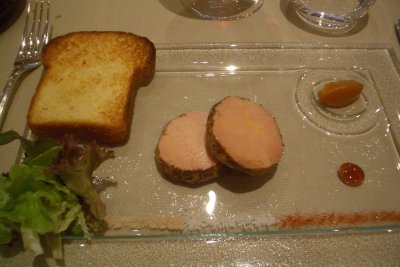
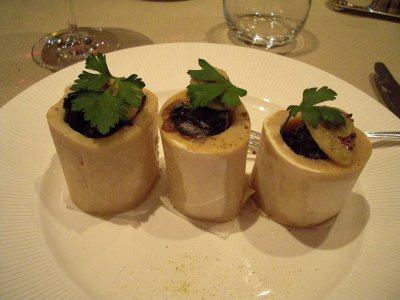 First course, David: Cold foie gras rolled in grilled mustard seed, a slice of toasted honey-flavored soda bread, and a chutney of turnips, sweet potato, and chardonnay.
First course, David: Cold foie gras rolled in grilled mustard seed, a slice of toasted honey-flavored soda bread, and a chutney of turnips, sweet potato, and chardonnay.
First course, me: Three large marrow bones, each resting on a little square of parchment paper and each filled with (from the bottom up) a purée of shallots cooked in red wine, a layer of shredded braised shallots, four snails, a slice of beef marrow with salt on top, and a parsley leaf. Sizzling hot and delicious!
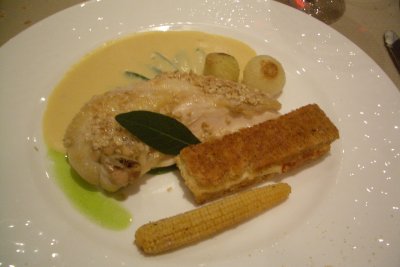
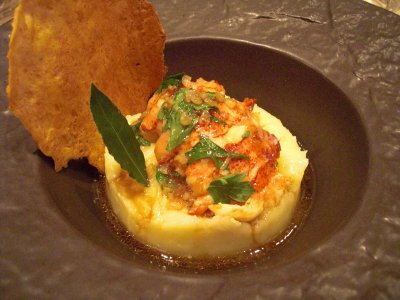 Second course, David: A breast of Bresse chicken sprinkled with oatmeal and cooked on a bed of hay (for the flavor; the hay is removed before serving), served on a fan of snow peas with a corn sauce, two small grilled onions, a little toasted cheese sandwich, and a roasted baby ear of corn. One or the other of us usually tries Bresse chicken on each trip—it's considered the ne plus ultra of chicken in France, but we're usually disappointed, I guess because we're accustomed to the very soft flesh of American speed-grown chickens (though the free-range chickens we raised when I was little were also very tender when cooked). Bresse chicken is generally very firm, tough by comparison with American chicken, and although good doesn't have the flavor I remember from childhood. David says the little grilled ear of corn was the most interesting thing on the plate.
Second course, David: A breast of Bresse chicken sprinkled with oatmeal and cooked on a bed of hay (for the flavor; the hay is removed before serving), served on a fan of snow peas with a corn sauce, two small grilled onions, a little toasted cheese sandwich, and a roasted baby ear of corn. One or the other of us usually tries Bresse chicken on each trip—it's considered the ne plus ultra of chicken in France, but we're usually disappointed, I guess because we're accustomed to the very soft flesh of American speed-grown chickens (though the free-range chickens we raised when I was little were also very tender when cooked). Bresse chicken is generally very firm, tough by comparison with American chicken, and although good doesn't have the flavor I remember from childhood. David says the little grilled ear of corn was the most interesting thing on the plate.
Second course, me: Atlantic lobster tail, "amandines" crushed with "policemen" (which turned out to be mashed potatoes with diced mild sausage in them), a potato cracker, and parsley-flavored meat juices. Delicious!
Cheese course, David: Brillat-Savarin, Comté, and something.
Cheese course, me: Cîteaux, fleur de maquis (a chevre from the south of France covered with chapparal herbs), Comté, and a chevre called Abbaye de something I couldn't make out. I wrote down "Plaqueville," but now I think it might have been "Pierre-Qui-Vire," having learned since that there is an abbey with that name.
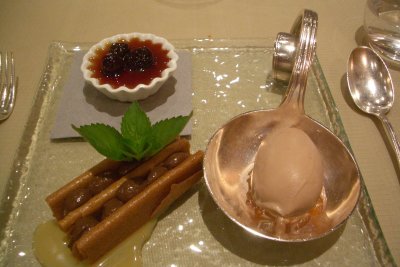
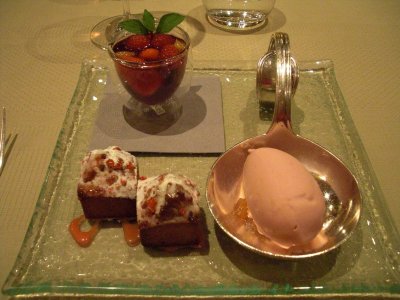 Dessert, David: A layered concoction of "gavotte" cookies (superthin crisp crepes rolled into flattened cylinders) sandwiched with chocolate-caramel cream; ice milk of "ovomaltine" (which I think is French for Ovaltine); and a coffee creme brulée with cherry sauce.
Dessert, David: A layered concoction of "gavotte" cookies (superthin crisp crepes rolled into flattened cylinders) sandwiched with chocolate-caramel cream; ice milk of "ovomaltine" (which I think is French for Ovaltine); and a coffee creme brulée with cherry sauce.
Dessert, me: "Raspberry wine" (actually red wine diluted with fruit juice) with its "fruits of the moment" (mostly strawberries and orange segments), strawberry sorbet, and little "financiers" loaf cakes sprinkled with pink pralines. The fruit and sorbet were delicious, but I had no apetite left for the cake . . .
While we were paying the (eminently reasonable) bill, I asked Madame the proprietress about her source of snails—did the restaurant acquire them alive? or prepared from a supplier who raised his own? were they locally grown? Alas, she didn't know their provenance; the restaurant acquires them, already parcooked, at the local covered market. Preparing snails from the living state is a complicated process and is considered a job for specialists. So I still don't know where all the "escargots bourguignon" actually come from.
previous entry
List of Entries
next entry

 Tuesday, the sun came out, so we set off toward the Office de Tourisme to see what Beaune had to offer. Along the way, in addition to the lively Place Carnot (with antique carousel in the center, of course), we passed many gorgeous shop windows—Beaune is particularly rich in "traiteurs" (prepared-food shops). The traiteur window on the left features mostly cold seafood (the meats were in the next case to the right)—smoked salmon in aspic, glazed poached salmon steaks, shrimp with lemon, etc. The one on the right shows mainly "charcuterie" (cured pork products) in the foreground, then various terrines further to the right. T he entirely green loaf at the left is "jambon persillé" (parsleyed ham), a great local specialty. A container (usually loaf or hemisphere shaped) is lined with ham-flavored aspic thickly studded with minced parsley. Then the rest is filled with a mixture of the same aspic and chunks of cooked ham, which gels when chilled. When sliced, it presents a lovely pink and green mosaic. The cones are small rolled hams. Next to them are cooked pigs' feet in aspic, then snails (cooked, replaced in the shell, and filled with garlic-parsley butter, ready for heating in the oven). The central green-topped loaf is a chilled terrine of ragout of snails and vegetables. It's intended to be sliced and eaten cold, but I'm sure they would also sell you a tub of ready-to-reheat snail ragout to be eaten hot.
Tuesday, the sun came out, so we set off toward the Office de Tourisme to see what Beaune had to offer. Along the way, in addition to the lively Place Carnot (with antique carousel in the center, of course), we passed many gorgeous shop windows—Beaune is particularly rich in "traiteurs" (prepared-food shops). The traiteur window on the left features mostly cold seafood (the meats were in the next case to the right)—smoked salmon in aspic, glazed poached salmon steaks, shrimp with lemon, etc. The one on the right shows mainly "charcuterie" (cured pork products) in the foreground, then various terrines further to the right. T he entirely green loaf at the left is "jambon persillé" (parsleyed ham), a great local specialty. A container (usually loaf or hemisphere shaped) is lined with ham-flavored aspic thickly studded with minced parsley. Then the rest is filled with a mixture of the same aspic and chunks of cooked ham, which gels when chilled. When sliced, it presents a lovely pink and green mosaic. The cones are small rolled hams. Next to them are cooked pigs' feet in aspic, then snails (cooked, replaced in the shell, and filled with garlic-parsley butter, ready for heating in the oven). The central green-topped loaf is a chilled terrine of ragout of snails and vegetables. It's intended to be sliced and eaten cold, but I'm sure they would also sell you a tub of ready-to-reheat snail ragout to be eaten hot.
 At the left here is more of one of the windows above. The labeled tub is filling for "bouchées à la reine" (i.e. puff pastry shells filled with creamed mushrooms and chicken). Others are various potato and vegetable salads.
At the left here is more of one of the windows above. The labeled tub is filling for "bouchées à la reine" (i.e. puff pastry shells filled with creamed mushrooms and chicken). Others are various potato and vegetable salads. While we were there, we cast an eye over a display of art by school children on the theme "Vegetal." Some cute stuff, but the best was this collaborative piece by four students, held over from a previous theme, "packaging."
While we were there, we cast an eye over a display of art by school children on the theme "Vegetal." Some cute stuff, but the best was this collaborative piece by four students, held over from a previous theme, "packaging." Then it was off to our first appointment, the 11:30 a.m. tour of La Moutarderie Fallot, located next door to last night's restaurant. On the internet, I had read a rather disparaging account of the tour by someone who was scandalized to learn that "Dijon mustard" was only a recipe, and in the public domain at that, rather than an "appellation controlée," but we thought it was great. Unfortunately, we didn't get actually to see the mustard being made, although later visitors will; the company is in the process of installing a system of viewing windows that will let tourists overlook the production floor without risk of contaminating the product (or being overcome by mustard fumes). Tours are limited to 20 people, and ours was about full but with people as sincerely interested as we were, so it went very well.
Then it was off to our first appointment, the 11:30 a.m. tour of La Moutarderie Fallot, located next door to last night's restaurant. On the internet, I had read a rather disparaging account of the tour by someone who was scandalized to learn that "Dijon mustard" was only a recipe, and in the public domain at that, rather than an "appellation controlée," but we thought it was great. Unfortunately, we didn't get actually to see the mustard being made, although later visitors will; the company is in the process of installing a system of viewing windows that will let tourists overlook the production floor without risk of contaminating the product (or being overcome by mustard fumes). Tours are limited to 20 people, and ours was about full but with people as sincerely interested as we were, so it went very well.
 Next, we got to make our own mustard! Several good-sided mortars and pestles were supplied and we were instructed (well, we just looked on while others did the grinding, as there weren't enough mortars for everyone) to start with a small handful of seed and grind it thoroughly, then to add a little of the wine-vinegar mix supplied, and a little salt before tasting the result. Everyone wound up adding too much salt, and the result was a little bitter, but the guide assured us that was normal—over the next few hours, with continued mixing, the bitterness would disappear.
Next, we got to make our own mustard! Several good-sided mortars and pestles were supplied and we were instructed (well, we just looked on while others did the grinding, as there weren't enough mortars for everyone) to start with a small handful of seed and grind it thoroughly, then to add a little of the wine-vinegar mix supplied, and a little salt before tasting the result. Everyone wound up adding too much salt, and the result was a little bitter, but the guide assured us that was normal—over the next few hours, with continued mixing, the bitterness would disappear. Finally, we were ushered into a tasting room, where the cloches were whisked off many small plates like this for our mustard tasting. Clockwise from the dollop of yellow "Moutarde de Bourgogne" at the top: cubes of pressed ham, coarse-grained pain d'épices mustard, minced-olive sandwiches, coarse-grained black-currant mustard, cubes of assorted vegetable terrines, smooth basil mustard, and tomato-mozzarella bites. Celery in the center.
Finally, we were ushered into a tasting room, where the cloches were whisked off many small plates like this for our mustard tasting. Clockwise from the dollop of yellow "Moutarde de Bourgogne" at the top: cubes of pressed ham, coarse-grained pain d'épices mustard, minced-olive sandwiches, coarse-grained black-currant mustard, cubes of assorted vegetable terrines, smooth basil mustard, and tomato-mozzarella bites. Celery in the center.  By this time, we were ravenous, so we went in search of lunch and found a great salad at a nearby café—jambon persillé, poached egg, and hot parsley-buttered snails. Fortified with that and a café liègeois for me, we set off to tour the Hospices de Beaune, also called the Hôtel Dieu.
By this time, we were ravenous, so we went in search of lunch and found a great salad at a nearby café—jambon persillé, poached egg, and hot parsley-buttered snails. Fortified with that and a café liègeois for me, we set off to tour the Hospices de Beaune, also called the Hôtel Dieu.
 Only when you pass through that building and enter the courtyard do you see the spectacular roof and ornate woodwork. The well in the courtyard supplied all the water for the complex, and fortunately, it was very deep, drawing its water from far below the level of the bottom of the local river, which passes under the building and into which, through slots in the floor (now glassed over), was pushed all the garbage, sewage, and medical waste from the hospital.
Only when you pass through that building and enter the courtyard do you see the spectacular roof and ornate woodwork. The well in the courtyard supplied all the water for the complex, and fortunately, it was very deep, drawing its water from far below the level of the bottom of the local river, which passes under the building and into which, through slots in the floor (now glassed over), was pushed all the garbage, sewage, and medical waste from the hospital. Inside one wing was the ward, fitted with 28 handsome and substantial curtained and canopied beds, each with its little side table and chair. the ceiling is extremely high (far overhead, "engoulants" hold the crossbeams in their wooden mouths), and the room is lit by windows above the beds. The ward held more than 28 patients, though, as each bed was occupied by two or three patients, sometimes four, at a time. The beds are rather short, as it was customary for the patients to sit up, at opposite ends of the bed, rather than to lie flat. The guide reminded us that these were the very poor, all badly injured or sick as dogs, many in pain and vocal about it, many dying. The nuns must have had their hands full. The nuns' sleeping quarters were on an upper floor of a wing, at right angles, and windows in the upper wall allowed them to keep watch over the ward at night. Two other, smaller rooms were also fitted as wards. The most striking feature of the wards, though, is that their architecture is that of a basilica, and for good reason—each is actually a church. That's why the place is also called the Hôtel Dieu—God's townhouse. At the end of each one is a choir and alter, just as in a regular Catholic church, and mass was said there, every three hours, round the clock, for the benefit of the patients (and for the soul of Nicholas Rolin).
Inside one wing was the ward, fitted with 28 handsome and substantial curtained and canopied beds, each with its little side table and chair. the ceiling is extremely high (far overhead, "engoulants" hold the crossbeams in their wooden mouths), and the room is lit by windows above the beds. The ward held more than 28 patients, though, as each bed was occupied by two or three patients, sometimes four, at a time. The beds are rather short, as it was customary for the patients to sit up, at opposite ends of the bed, rather than to lie flat. The guide reminded us that these were the very poor, all badly injured or sick as dogs, many in pain and vocal about it, many dying. The nuns must have had their hands full. The nuns' sleeping quarters were on an upper floor of a wing, at right angles, and windows in the upper wall allowed them to keep watch over the ward at night. Two other, smaller rooms were also fitted as wards. The most striking feature of the wards, though, is that their architecture is that of a basilica, and for good reason—each is actually a church. That's why the place is also called the Hôtel Dieu—God's townhouse. At the end of each one is a choir and alter, just as in a regular Catholic church, and mass was said there, every three hours, round the clock, for the benefit of the patients (and for the soul of Nicholas Rolin).
 The altarpiece from the large ward, a world art treasure painted in strictly Flemish style, is displayed separately in a special dimly-lit, climate-controlled room. Closed, it shows Nicholas and his second wife, Guigone des Salins, kneeling in prayer and a couple of saints, all in muted colors. Open, it displays a brilliantly colored scene of the last judgement. (My wonderful little digital camera, this year's Christmas present, did an amazing job of capturing it without flash, even in the dim light.) A railing keeps you about five feet from it, but a giant lens, perhaps 18 inches across, is mounted on a frame that periodically slides back and forth and up and down across in front of the painting, pausing to magnify the best details. It is truly magnificent, although it serves to remind me that Flemish painting protrays no nudes, only naked people.
The altarpiece from the large ward, a world art treasure painted in strictly Flemish style, is displayed separately in a special dimly-lit, climate-controlled room. Closed, it shows Nicholas and his second wife, Guigone des Salins, kneeling in prayer and a couple of saints, all in muted colors. Open, it displays a brilliantly colored scene of the last judgement. (My wonderful little digital camera, this year's Christmas present, did an amazing job of capturing it without flash, even in the dim light.) A railing keeps you about five feet from it, but a giant lens, perhaps 18 inches across, is mounted on a frame that periodically slides back and forth and up and down across in front of the painting, pausing to magnify the best details. It is truly magnificent, although it serves to remind me that Flemish painting protrays no nudes, only naked people.
 The first amuse-bouche was little warm sausage-studded cakes; crisp, sharp-flavored cheese cookies with poppy seeds, and a glass of little green olives.
The first amuse-bouche was little warm sausage-studded cakes; crisp, sharp-flavored cheese cookies with poppy seeds, and a glass of little green olives.
 First course, David: Cold foie gras rolled in grilled mustard seed, a slice of toasted honey-flavored soda bread, and a chutney of turnips, sweet potato, and chardonnay.
First course, David: Cold foie gras rolled in grilled mustard seed, a slice of toasted honey-flavored soda bread, and a chutney of turnips, sweet potato, and chardonnay.
 Second course, David: A breast of Bresse chicken sprinkled with oatmeal and cooked on a bed of hay (for the flavor; the hay is removed before serving), served on a fan of snow peas with a corn sauce, two small grilled onions, a little toasted cheese sandwich, and a roasted baby ear of corn. One or the other of us usually tries Bresse chicken on each trip—it's considered the ne plus ultra of chicken in France, but we're usually disappointed, I guess because we're accustomed to the very soft flesh of American speed-grown chickens (though the free-range chickens we raised when I was little were also very tender when cooked). Bresse chicken is generally very firm, tough by comparison with American chicken, and although good doesn't have the flavor I remember from childhood. David says the little grilled ear of corn was the most interesting thing on the plate.
Second course, David: A breast of Bresse chicken sprinkled with oatmeal and cooked on a bed of hay (for the flavor; the hay is removed before serving), served on a fan of snow peas with a corn sauce, two small grilled onions, a little toasted cheese sandwich, and a roasted baby ear of corn. One or the other of us usually tries Bresse chicken on each trip—it's considered the ne plus ultra of chicken in France, but we're usually disappointed, I guess because we're accustomed to the very soft flesh of American speed-grown chickens (though the free-range chickens we raised when I was little were also very tender when cooked). Bresse chicken is generally very firm, tough by comparison with American chicken, and although good doesn't have the flavor I remember from childhood. David says the little grilled ear of corn was the most interesting thing on the plate.
 Dessert, David: A layered concoction of "gavotte" cookies (superthin crisp crepes rolled into flattened cylinders) sandwiched with chocolate-caramel cream; ice milk of "ovomaltine" (which I think is French for Ovaltine); and a coffee creme brulée with cherry sauce.
Dessert, David: A layered concoction of "gavotte" cookies (superthin crisp crepes rolled into flattened cylinders) sandwiched with chocolate-caramel cream; ice milk of "ovomaltine" (which I think is French for Ovaltine); and a coffee creme brulée with cherry sauce.